Answers For Nervous Inductees and Their Families
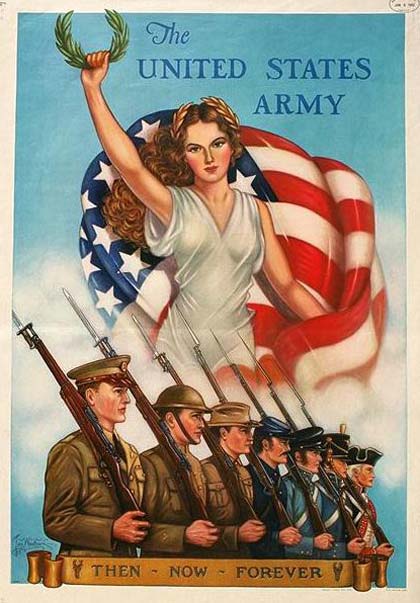 An Army poster promotes patriotism and tradition. Graphic design with allegorical female courtesy Northwestern University Library
An Army poster promotes patriotism and tradition. Graphic design with allegorical female courtesy Northwestern University Library
The federal government faced the challenge of mobilizing millions of men and women for service in the armed forces during the war. Well before the U.S. entry into the war and despite strong isolationist sentiments across the country, Congress passed the Selective Training and Service Act of 1940 authorizing a draft. By October 1940 all men between the ages of 21 and 35 were required to register with their local draft board. During the first few years of the draft, information about the induction process, life in the military, and
related topics was not given to potential inductees in a unified and comprehensive way. Many times inductees learned important information by word of mouth or discovered things they should have done after it was too late. The resulting apprehension, confusion, and family hardships led the U.S. Office of Civilian Defense and other federal agencies to promote pre-induction information programs across the country.
Overview of the Draft
The implementation of America's first peacetime draft went relatively smoothly. In Congress, the argument for conscription after the collapse of western Europe and the fall of France earlier in the 1940 overcame the bitter opposition of the anti-interventionists. On Oct.
16, 1940 over 16 million men registered for the draft at one of nearly 6,500 selective service boards across the country. Each registrant received a draft number from one to 9,000. A national lottery later determined the order in which each of the numbers was called and, by extension, who would be drafted first.
Footnote 1
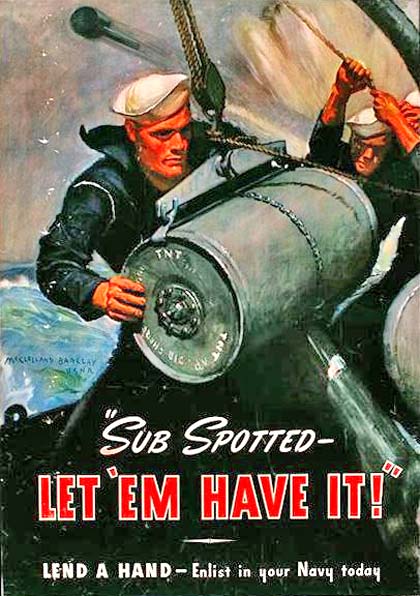 The Navy filled its ranks completely with volunteers until early 1943. Graphic image of sailors courtesy Northwestern University Library
The Navy filled its ranks completely with volunteers until early 1943. Graphic image of sailors courtesy Northwestern University Library
Local boards, staffed by prominent or influential volunteers, oversaw the draft process. The federal government gave these boards authority to make judgments based on the standards and mores of their communities as well as civilian production needs. While this freed the process from some of the chokingly detailed regulations that would have arisen, it also resulted in favoritism from time to time. The local draft boards, augmented by hundreds of appeals boards, oversaw the registration process, received deferment or conscientious objector status requests, and heard appeals.
The boards could classify a potential draftee into one of a number of classifications ranging from 1-A, meaning "available for military service," to 4-F, meaning "physically, mentally or morally unfit for service." Anyone classified other than 1 was considered deferred but an individual's classification could change depending on the
situation. Deferments were available based on medical, psychological, educational, family, or occupational status. In all, about 10 million men received exemptions or deferments, with about 4.5 million of them appealing their classification. At first the system did not draft married men, which led to a "marriage boom." Fathers were not drafted until late 1943 and then only over the opposition of one U.S. Senator who insisted that "slackers in the government bureaus" should be inducted "before American homes are broken up." Others favored first conscripting "those unmarried men who shun work and are found in pool rooms, barrel houses, and on the highways and byways." Eventually about four million men received deferments based on a growing list of "essential" occupations, mostly in agriculture and industry.
Footnote 2
More than 5 million potential draftees were rejected for medical, educational, or mental reasons. This was despite relatively low standards for acceptance. For example, the Army would accept draftees who were at least 5 feet tall and 105 pounds, provided they had correctable vision, half of their natural teeth, no hernias, flat feet, or venereal disease. As evidence of the crippling effect of the Depression on public education, hundreds of thousands of men signed their draft registration forms with a mark because they could not sign their own names. Before the end of the war the Army was so desperate for men that it set up special schools to bring illiterate draftees up to a 4th-grade reading level.
Meanwhile, about 3 million men were rejected because of "emotional instability." Some experts blamed this on "Momism" and a War Department consultant commented that many women "had failed in the elementary mother function of weaning offspring emotionally as well as physically."
Footnote 3
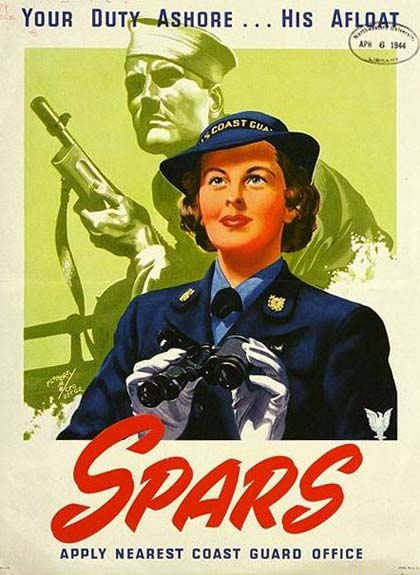 About 350,000 women joined military programs such as the WACs, WAVES, and SPARs during the war. U.S. Coast Guard SPARS image courtesy Northwestern University Library
About 350,000 women joined military programs such as the WACs, WAVES, and SPARs during the war. U.S. Coast Guard SPARS image courtesy Northwestern University Library
At its peak in 1945, the military counted more than 12 million GIs on active service while about 16 million served at one time or another during the course of the
war.
The attack on Pearl Harbor and the declaration of war in December 1941 brought a significant expansion of the draft. At its peak in 1945, the military counted more than 12 million GIs on active service while about 16 million served during the course of the war. During that time, the Selective Service System registered about 50 million men from 18 to 64 years of age while it drafted over 10 million men from 18 to 38 years of age. In addition, about 5.7 million men and 350,000 women volunteered for service in the armed forces. In fact, until early 1943, the Navy and the Marine Corps relied solely on volunteers before their needs required tapping the draft.
Footnote 4
Organizing Pre-Induction Information Programs
By 1943 federal officials had seen enough apprehension and fielded enough complaints about spotty information for inductees and their families. The U.S. Office of Civilian Defense and other federal agencies developed a program that offered answers to common questions brought by inductees. In turn, the federal government sought to enlist the help of state defense councils to implement the program around the country. Government officials reasoned that "if a prospective inductee knows what the Army expects of him, what tests and training he may expect to go through, what kind of life he will live, and what kind of war we are fighting, he will enter the service with greater confidence and assurance. He will adjust more readily to the new situation and probably develop more quickly into a good soldier."
Footnote 5
 Many remote areas of Malheur County needed
their Oregon pre-induction informational broadcasts via a
Nampa, Idaho radio station. Shown above are the county's "Pillars of Rome." (Image no. 20130620-D8C_1623, Oregon Scenic Photos, OSA)
Enlarge image
Many remote areas of Malheur County needed
their Oregon pre-induction informational broadcasts via a
Nampa, Idaho radio station. Shown above are the county's "Pillars of Rome." (Image no. 20130620-D8C_1623, Oregon Scenic Photos, OSA)
Enlarge image
In Oregon, the State Defense Council got the program running in early 1944.
The council settled on orientation meetings, which would be given in cities and towns across the state. Before implementing the system, however, several test or rehearsal meetings were held with groups of inductees to experiment with presentations. A plan evolved that typically included the participation of a range of experts from the armed forces, Red Cross, selective service, state bar association and social agencies.
The meetings generally would include a film describing life in the military followed by short talks and question and answer sessions. (
 Oregon Pre-induction program
Oregon Pre-induction program )
Footnote 6 Federal authorities recommended that meetings start with band music or group singing to set the right tone. Their sternest advice concerned long-winded presenters: "The most common criticism of the meetings is directed at the number and length of the speeches. If the films are used, and if the leaflets are distributed during or at the close of the meeting, very little speech-making should be necessary."
Footnote 7
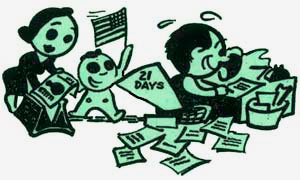 After going to the induction station for a day, draftees had at least 21 days at home to take care of business and say goodbye to friends and relatives. Making sure
paperwork was in order for family members to receive allotments was a key task. (Folder 2, Box 35, Defense Council Records, OSA.)
After going to the induction station for a day, draftees had at least 21 days at home to take care of business and say goodbye to friends and relatives. Making sure
paperwork was in order for family members to receive allotments was a key task. (Folder 2, Box 35, Defense Council Records, OSA.)
More remote communities, especially in eastern Oregon, were served by radio program transcriptions. To accomplish this, the State Defense Council "engaged a group of radio players on the staff of radio station KGW, Portland, to produce three 15 minute programs patterned after meetings with members of the panel.... The program is built around the March of Time style with fanfare music in the opening and is an excellent piece of work." To further "this ingenious radio meeting plan," the council enlisted local newspapers to carry a front page box to promote each broadcast. This worked well except for in Malheur County where "it was discovered that their best radio reception comes from radio stations located in Nampa and Boise, Idaho." A flurry of letters to the Idaho State Defense Council and Idaho radio stations eventually secured the broadcast of the programs on a Nampa station.
Footnote 8
The pre-induction information program in Oregon moved forward quickly during the spring of 1944. Multnomah County was drawing in an average of 300 inductees and family members to weekly meetings. Marion County typically saw a crowd of from 30 to 50 people at its meetings, which were held twice a month. Most participating counties held monthly meetings or "on draft calls." These meetings usually brought from 15 to 75 people depending on the size of the county and the draft call. Even though some counties were still in the process of organizing meetings, by July 1944 one State Defense Council official was confident of full statewide coverage either in open forum meetings or by radio broadcasts, saying that "as recently as last week, ...on a trip through the state, [a State Defense Council employee] lined up three counties hitherto only lukewarm on the idea."
Footnote 9Draftees Get Their Affairs in Order
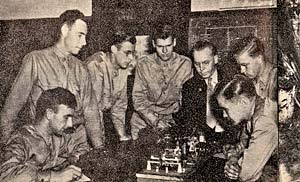 Men with 3
months before induction could enroll in pre-induction training courses that could help them get a desirable job in the military. (Folder 2, Box 35, Defense Council Records, OSA.)
Men with 3
months before induction could enroll in pre-induction training courses that could help them get a desirable job in the military. (Folder 2, Box 35, Defense Council Records, OSA.)
While presenters in pre-induction meetings tailored
answers to local situations, much of the material they used
conformed to information provided by
the military and federal and state civilian defense organizations.
Many questions centered on what the inductee needed to do before reporting for service. For instance, after a one-day stint at an induction station, draftees were sent home for at least 21 days to clear up personal and business affairs. Officials urged men to arrange for the settlement of their current financial obligations such as taxes, loans, credit debt and mortgages. The Soldiers' and Sailors' Civil Relief Act included relevant provisions, so getting legal advice was recommended. Inductees often needed to secure allotment checks for dependents such as wives, children, and parents to provide for them while in the service. The allotments weren't much money but they were better than nothing - $50 for a wife or other adult dependent ($22
of that was to be deducted from the serviceman's paycheck) and more money for each child. Other tasks such as purchasing life insurance and transferring power of attorney also came into play.
Footnote 10
On to the Army Reception Center
A Portland Induction Station officer "warned the men that if they don't trust their wives, they are not to give them powers-of-attorney. There are cases on record where a man had given his wife power-of-attorney and she sold him
out."Footnote 11
After getting affairs in order and saying goodbyes, draftees were sent for 3-5
days at a reception center. Men were cautioned not to "celebrate on the night before you have to leave for the Reception Center" since they would be given a battery of tests and "you'll want to be on your toes." They were also told to travel light: "Don't pack a trunk. Take along a small overnight bag with razor, toothbrush, change of underwear, extra handkerchiefs." After swearing in, the new soldiers (in the case of the Army, although Navy training centers were similar) would get a stark reminder that they were no longer in the civilian world for as officials noted: "There's no privacy for the private." In the company barracks, the soldiers would "eat and sleep, work and play, toilet and dress right along with a whole bunch of other fellows who are doing the same thing." The Army supplied clothing and shoes that were "carefully fitted by tailors and shoe experts" along with toiletries. New soldiers were warned to keep track of their clothing since "you will have to pay for any articles you may lose." Aptitude and classification tests were followed by interviews in which Army staff weighed various skills and other criteria along with military needs to arrive at an assignment for the new soldier.
Footnote 12 Personal preferences for job assignments were part of the decision process but no promises were made:
An artist, quite naturally, would think he ought to be put to use in the camouflage department, or into some department where they would use his artistic ability. A lawyer would feel like he ought to be put in the Judge Advocate General's office. A movie producer... feels he ought to be put in the Signal Corps and given the job of producing some of these Army training films.
Machine gunners, tank drivers and automobile mechanics are worried, and frequently resentful, until they are told why the Army has had to put them there.
The answer is simple. The Army does not need so many artists, movie producers, lawyers. They need machine gunners, tank drivers and automobile mechanics.
Footnote 13
Basic Training
Soldiers next landed for 17 weeks of basic training where, according to pre-induction education literature, they gave up their minds and bodies to a ritual of calisthenics, close-order drills, military indoctrination, and Army discipline. Soldiers learned methods of self-protection, camouflage, care and use of weapons, and how to be part of a combat team. Sailors learned a variation on the Army theme with training in elements of seamanship, gunnery, signals
and Navy language. For those in the Marine Corps, "'Boot Camp' will probably be an ordeal for you. It is not easy. The day begins at 4:45 and when it ends at 8 P.M. you will greet sleep with pleasure." Officials noted that 90%
of marines on duty were combat troops who would likely see battle and while they were "taught to consider your rifle the best friend you ever had," it was fighting battles together that would build lifelong comrades in the Marine Corps. After basic training, many soldiers, sailors
and marines were sent to their assigned duty. Others, depending on their specialty, required further training that could last up to a year. Most served for the duration of the war plus six months, unless the military chose to discharge them early.
Footnote 14Food, Pay and Recreation
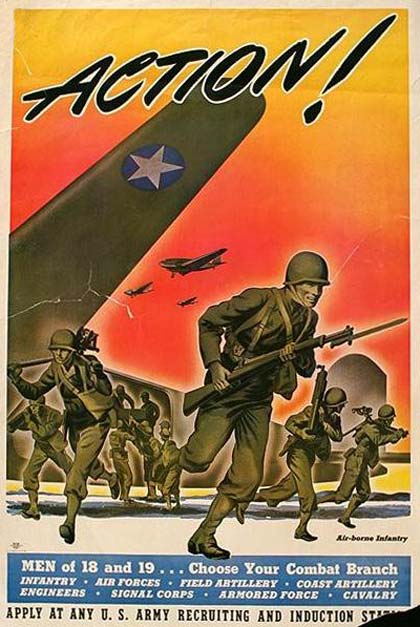 A poster urges young men to get
in
the action in the Army, and ways to do it. Another branch, the Marine Corps boasted that 90%
of
members saw battle. Poster image courtesy Northwestern University Library
A poster urges young men to get
in
the action in the Army, and ways to do it. Another branch, the Marine Corps boasted that 90%
of
members saw battle. Poster image courtesy Northwestern University Library
Pre-induction meetings also described other aspects of life in the military. For example, claiming
"no soldier or sailor in the world is better fed than the American soldier or sailor," officials described a sample menu for soldiers and sailors that weighed about five pounds per person per day: Breakfast: fruit or juice, cereal, milk, eggs, bread and butter, coffee; Dinner: roast or chops, 2 vegetables, salad, bread and butter, dessert, tea or coffee; Supper: soup, meat dish, 2 vegetables, bread and butter, dessert, coffee. In the field, soldiers often had to rely on packaged emergency meals known as K rations with the following sample contents: Breakfast: chopped beef and egg white, biscuits, fruit bar, coffee powder, sugar, cigarettes, chewing gum; Dinner: American cheese and bacon, malted milk and dextrose tablets, biscuits, lemon powder, sugar, cigarettes, chewing gum; Supper: bouillon powder, corned pork loaf, biscuits, chocolate bar, sugar, cigarettes, chewing gum. Servicemen held decidedly less appreciation for the quality of the meals than their superiors. And to add more suffering to the experience, many had to take part in kitchen patrol or KP duty during which hours were spent washing dishes, peeling potatoes, or "slinging hash" for fellow troops.
Footnote 15
The pay was small but, according to pre-induction meetings, it was decent compensation if all the benefits were calculated. Buck privates and apprentice seamen earned a paltry $50
a month. The highest noncommissioned officers, master sergeants in the Army and chief petty officers in the Navy, earned $138
a month. But Office of War Information officials said people should include room, board, and other benefits in the equation "to show what a private or apprentice seaman really gets" per year: Cash - $600; Food - $576.50; Shelter - $120; Equipment - $170; Health care - $100; Life insurance savings - $63.40; Cigarettes savings - $10.95; Laundry savings - $32.50; Postage and barber savings - $26.65. The optimistic total rose to $1,700 per year.
Footnote 16
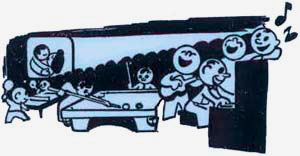 Pre-induction informational literature showed servicemen enjoying recreation halls in military camps. (Folder 2, Box 35, Defense Council Records, OSA.)
Pre-induction informational literature showed servicemen enjoying recreation halls in military camps. (Folder 2, Box 35, Defense Council Records, OSA.)
If the serviceman would not get rich, at least he could look forward to recreation. While in camp, most soldiers and sailors had evenings and Sundays as free time. Pre-induction meeting presenters described company day rooms
equipped with books and easy chairs and often had pool or ping-pong tables. More enjoyment was available at recreation halls and post exchanges (PX) "where you can gather around for sodas and conversation." Men were encouraged to organize teams to play baseball, basketball, football and other sports. Officials boasted "you will be able to see the latest movies, sometimes even before they hit the big cities, for only about 20 cents." Moreover, stage, screen, and radio stars sometimes performed for troops at the recreation hall. Talent shows and post dances rounded out the camp entertainment. Many servicemen really looked forward to the recreation available away from the camp. And, many towns offered special dormitories and canteens in conjunction with the United Service Organizations (USO), Red Cross, local churches
and civic groups, not to mention the many illicit options related to gambling and prostitution.
Footnote 17